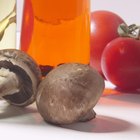bhofack2/iStock/GettyImages
Selenium might not get the same attention as more well-known vitamins and minerals such calcium, but it nonetheless is an essential mineral your children need in their everyday diet. Fortunately, it's also an extremely prevalent mineral in Western diets, so your children are probably already getting enough selenium. Even so, consider selenium another motivation to give your children a healthy, well-balanced diet.
Identification
Selenium is a trace mineral the body needs to function properly. It helps the body create the antioxidant enzymes that help keep the cells healthy. It's particularly important for your children when they receive immunizations, because it helps stimulate antibodies and make the immunization more effective. Selenium is present in soil and therefore is most highly concentrated in plant-based foods grown in selenium-rich soil, including fruits, vegetables and breads. It's also present in meat when the animals had a plant- or grain-based diet that was high in selenium.
Needed Levels
Adults need about 55 micrograms, or mcg, of selenium each day, but your children need less. Children between the ages of 1 and 3 need 20 mcg per day, children 4 to 8 need 30 mcg per day and children 9 to 13 need 40 mcg per day. Once children reach 14, they need the same amount of selenium as adults. Too much selenium can be harmful. The U.S. Food and Nutrition Board suggests children 1 to 3 limit their intake to 90 mcg per day, children 4 to 8 to 150 mcg, children 9 to 13 to 280 mcg and older children to 400 mcg. Illness from too much selenium, however, is extremely rare.
Sources
If your children are eating a balanced diet that includes fruits, vegetables, proteins and grains, they probably are already getting sufficient selenium in their diets. A single egg, for example, contains about 14 mcg of selenium, about half of what children need in a day. A tuna sandwich on whole-wheat bread is packed with selenium. Three oz. of tuna contains about 63 mcg of selenium, and each slice of wheat bread contains about 10 mcg. Cod, chicken breast, rice, oatmeal and enriched pasta are also excellent sources of selenium. Selenium-rich vegetables include mushrooms, spinach, asparagus and broccoli. Even picky children will try these vegetables if you tempt them with some creamy dressing for dipping.
Considerations
Soils in Nebraska and the Dakotas are particularly high in selenium, and because foods from those states are shipped all over the United States, selenium deficiency is extremely rare in the country, according to the U.S. Office of Dietary Supplements. Only in areas with selenium-poor soil and little food distribution from outside regions, such as certain parts of China and Russia, is selenium deficiency a significant problem. Even if your child is a picky eater, selenium is one nutrient you probably don't need to worry about. If your child has an eating disorder or other diet-related health issues, you might need to include a daily multivitamin, but you should seek advice from your child's doctor first.
Related Articles

Is Zinc Good for Hair Growth?

What Vitamins Help the Liver?

Vitamin B6 Dosing for Children

L-Lysine for Hair Growth

Potassium in Pinto Beans

Selenium & Silica

Choline in Eggs
Nutrition to Help Your Child Grow Taller
Low-Potassium Meals

A List of Foods That Contain Choline

Vitamins for Mental Alertness

Zinc Treatment for Rosacea

A Low-Cholesterol Diet Plan Menu

How Much Calcium Is in Peanut Butter?

What Are the Benefits of Great Northern ...

A Healthy Food Timetable for Kids

Peanuts Vs. Pistachios

Mineral Oil Vs. Olive Oil
The Best Companion Foods for Vitamin & ...

Strontium-Rich Foods
References
Resources
Writer Bio
Michael Baker has worked as a full-time journalist since 2002 and currently serves as editor for several travel-industry trade publications in New York. He previously was a business reporter for "The Press of Atlantic City" in New Jersey and "The [Brazoria County] Facts" in Freeport, Texas. Baker holds a Master of Science in journalism from Quinnipiac University in Hamden, Conn.